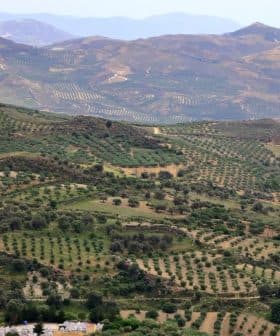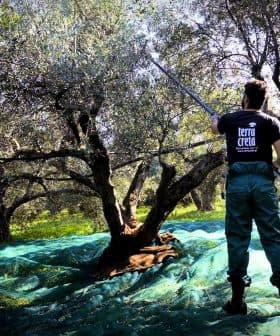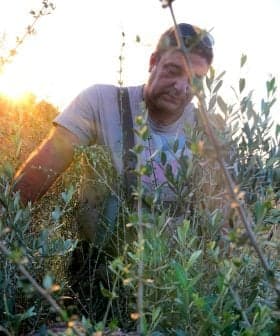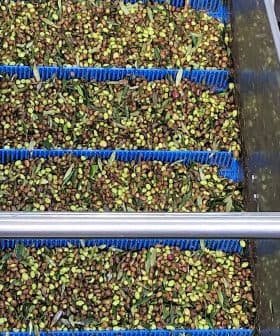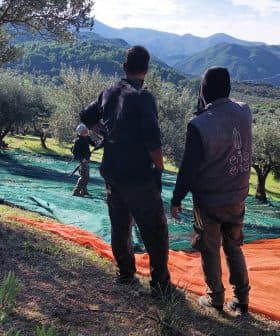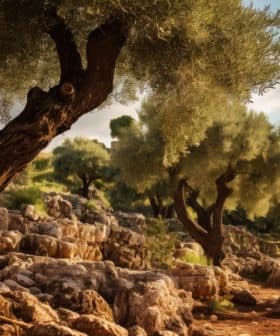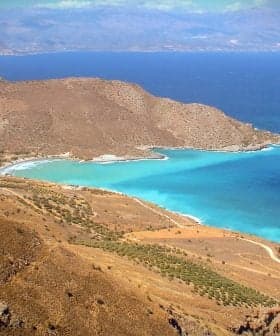Olive Oil Flows at Harvest Time on Crete
Local officials in Crete opened a three-day event promoting the island’s olive oil abroad, funded by the International Olive Council and other organizations, with lectures on olive oil quality and health benefits. Producers in the region face market challenges, with efforts to build long-term relationships and assure buyers of quality through labeling.
Local officials addressed journalists from eight countries to Crete today to open a three-day event promoting the island’s olive oil abroad. The program was funded by the International Olive Council, the Institute for Olive Tree and Subtropical Plants of Chania, and the Cretan Quality Agreement.
After a welcome by civic leaders a series of lectures offered an overview of the factors that influence olive oil quality, the organoleptic assessment of certain local varietals, and data supporting the health benefits of Crete’s traditional diet, like the low morbidity of Cretans who are said to be the world leaders in olive oil consumption.
 Visitors were treated to unusually warm weather as olive trees, which seemed to be everywhere on the 3,200 square mile island, were heavy with fruit. Harvesting was witnessed throughout the day, mostly by motorized rakes, on the steep hills that characterize western Crete’s cultivation. Bags full of the small purple-green Koroneiki olives that dominate the region lay at the end of driveways to be picked up. At dusk lines of pickup trucks formed at local mills and pallets piled with the day’s harvest
Visitors were treated to unusually warm weather as olive trees, which seemed to be everywhere on the 3,200 square mile island, were heavy with fruit. Harvesting was witnessed throughout the day, mostly by motorized rakes, on the steep hills that characterize western Crete’s cultivation. Bags full of the small purple-green Koroneiki olives that dominate the region lay at the end of driveways to be picked up. At dusk lines of pickup trucks formed at local mills and pallets piled with the day’s harvest
waited outside.
One mill was operated by Terra Creta. Installed last year, the 2 million euro processing facility cleaned, crushed and pressed in a continuous process fruit from about 15 regional farms, and its own trees which make up 8 percent of its total output, projected to reach one million kilos this year.
Terra Creta export manager Fotis Sousalis said 70% of the firm’s production is from the designated origin Kolymvari of Northwestern Crete, and 15% is organic. Sales in the United States account for a third of annual revenue, following successful entries into regional supermarket chains, most recently in the Southeast.
 As the region’s producers face the daunting market challenges of historically low world prices, stiff competition from emerging players and higher quality expectations by an increasingly educated consumer, Sousalis hopes to forge long-term relationships with local farms.
As the region’s producers face the daunting market challenges of historically low world prices, stiff competition from emerging players and higher quality expectations by an increasingly educated consumer, Sousalis hopes to forge long-term relationships with local farms.
He said the area’s cooperatives closed years ago and a contractual collaboration was viewed as an important next step that would allow the company and its partners to compete against such well-organized competitors.
In a sign of the times, acidity levels and lot codes are appearing on labels from Cretan producers to assure buyers that the product is below the European Community’s 0.8% extra virgin threshold. Still, most levels observed were in the range of 5 to 6 percent which is considerably higher than the acidity commonly associated with premium olive oils. Of course on this island that provides 5 percent of the world’s olive oil, there are producers making oils with a broad range of quality and price levels.
Up a winding road to a hilltop with an impossibly perfect view of the Mediterranean Sea, deep green olive groves and red cliffs, Biolea marked a contrast to the whir of automatic production.
Run by the husband and wife team of George Dimitriadis and Christine Lacroix, Biolea decided on a business approach guided by three principles: sustainability, olive oil quality and transparency.
 Its hillside groves are maintained without irrigation. Inside, skilled workers demonstrated to visitors ancient and increasingly rare methods using a stone mill and traditional presses. Dimitriadis said the countless split decisions made by mill workers during the process result in an oil quality hard to achieve by modern means. Optimal milling times vary depending on the ripeness of the fruit, for example.
Its hillside groves are maintained without irrigation. Inside, skilled workers demonstrated to visitors ancient and increasingly rare methods using a stone mill and traditional presses. Dimitriadis said the countless split decisions made by mill workers during the process result in an oil quality hard to achieve by modern means. Optimal milling times vary depending on the ripeness of the fruit, for example.
Dimitriadis also noted that since his stone mill doesn’t completely pulverize pits and skin, those elements don’t contribute their bitterness to the oil as they do in modern crushers resulting, he said, in his oil’s nicer profile. He maintains this gentler treatment retains more of the fruit’s healthful properties. A sampling of olive oil pressed just minutes before did reveal a taste which was delightful: green, fruity, medium intensity and less bitter than other local tastings.
At every turn the international visitors were greeted with warm hospitality and typical Cretan fare which is as delicious as it is rich with extra virgin olive oil. It’s not hard to see how the average Cretan consumes an astounding average intake said to exceed 35 liters per year.
.
.



